How To Draw A Komodo Dragon Face
| Komodo dragon Temporal range: | |
|---|---|
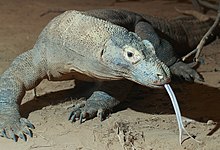 | |
| Male person at the Cincinnati Zoo | |
| Conservation status | |
| | |
| CITES Appendix I (CITES)[three] | |
| Scientific nomenclature | |
| Kingdom: | Animalia |
| Phylum: | Chordata |
| Form: | Reptilia |
| Lodge: | Squamata |
| Family: | Varanidae |
| Genus: | Varanus |
| Subgenus: | Varanus |
| Species: | V. komodoensis |
| Binomial name | |
| Varanus komodoensis Ouwens, 1912[4] | |
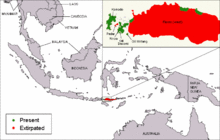 | |
| Komodo dragon distribution | |
The Komodo dragon (Varanus komodoensis), likewise known as the Komodo monitor, is a member of the monitor lizard family Varanidae that is owned to the Indonesian islands of Komodo, Rinca, Flores, and Gili Motang. Information technology is the largest extant species of lizard, growing to a maximum length of 3 metres (10 ft), and weighing up to approximately lxx kilograms (150 lb).
Every bit a issue of their size, Komodo dragons are apex predators, and dominate the ecosystems in which they live. Komodo dragons hunt and deadfall casualty including invertebrates, birds, and mammals. It has been claimed that they have a venomous seize with teeth; there are two glands in the lower jaw which secrete several toxic proteins. The biological significance of these proteins is disputed, but the glands accept been shown to secrete an anticoagulant. Komodo dragons' group beliefs in hunting is exceptional in the reptile world. The diet of Komodo dragons mainly consists of Javan rusa (Rusa timorensis), though they also eat considerable amounts of carrion. Komodo dragons also occasionally attack humans.
Mating begins between May and August, and the eggs are laid in September; every bit many as xx eggs are deposited at a time in an abandoned megapode nest or in a cocky-dug nesting pigsty. The eggs are incubated for seven to eight months, hatching in April, when insects are most plentiful. Immature Komodo dragons are vulnerable and dwell in trees to avoid predators, such as cannibalistic adults. They have 8 to nine years to mature and are estimated to live upwardly to 30 years.
Komodo dragons were first recorded by Western scientists in 1910. Their large size and fearsome reputation make them popular zoo exhibits. In the wild, their range has contracted due to man activities, and is likely to contract further from the furnishings of climate alter; due to this, they are listed as Endangered by the IUCN Red List. They are protected nether Indonesian law, and Komodo National Park was founded in 1980 to help protection efforts.
Taxonomic history
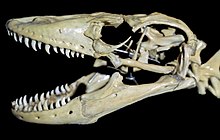
Komodo dragons were first documented by Europeans in 1910, when rumors of a "land crocodile" reached Lieutenant van Steyn van Hensbroek of the Dutch colonial administration.[five] Widespread notoriety came afterward 1912, when Peter Ouwens, the director of the Zoological Museum of Bogor, Java, published a paper on the topic after receiving a photograph and a skin from the lieutenant, likewise every bit two other specimens from a collector.[4]
The first 2 alive Komodo dragons to arrive in Europe were exhibited in the Reptile Business firm at London Zoo when it opened in 1927.[vi] Joan Beauchamp Procter made some of the earliest observations of these animals in captivity and she demonstrated their behaviour at a Scientific Meeting of the Zoological Society of London in 1928.[seven]
The Komodo dragon was the driving cistron for an expedition to Komodo Island past W. Douglas Burden in 1926. Subsequently returning with 12 preserved specimens and two live ones, this trek provided the inspiration for the 1933 movie King Kong.[8] It was also Burden who coined the common name "Komodo dragon."[9] Three of his specimens were stuffed and are withal on display in the American Museum of Natural History.[10]
The Dutch island administration, realizing the express number of individuals in the wild, presently outlawed sport hunting and heavily limited the number of individuals taken for scientific study. Collecting expeditions ground to a halt with the occurrence of World War II, non resuming until the 1950s and 1960s, when studies examined the Komodo dragon's feeding behavior, reproduction, and body temperature. At around this time, an expedition was planned in which a long-term written report of the Komodo dragon would be undertaken. This task was given to the Auffenberg family unit, who stayed on Komodo Isle for 11 months in 1969. During their stay, Walter Auffenberg and his assistant Putra Sastrawan captured and tagged more than than 50 Komodo dragons.[11]
Enquiry from the Auffenberg trek proved to exist enormously influential in raising Komodo dragons in captivity.[12] Research later that of the Auffenberg family has shed more than light on the nature of the Komodo dragon, with biologists such as Claudio Ciofi continuing to study the creatures.[13]
Etymology
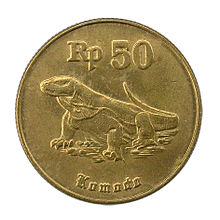
The Komodo dragon, every bit depicted on the 50 rupiah money, issued past Indonesia
The Komodo dragon is also sometimes known equally the Komodo monitor or the Komodo Island monitor in scientific literature,[fourteen] although this name is uncommon. To the natives of Komodo Island, it is referred to equally ora, buaya darat ('land crocodile'), or biawak raksasa ('behemothic monitor').[15] [5]
Evolutionary history
The evolutionary development of the Komodo dragon started with the genus Varanus, which originated in Asia about 40 one thousand thousand years ago and migrated to Australia, where information technology evolved into giant forms (the largest of all beingness the recently extinct Megalania), helped by the absence of competing placental carnivorans. Around 15 million years ago, a collision between the continental landmasses of Australia and Southeast Asia immune these larger varanids to motility back into what is now the Indonesian archipelago, extending their range as far east as the island of Timor.
The Komodo dragon is believed to accept differentiated from its Australian ancestors almost 4 million years ago. However, recent fossil evidence from Queensland suggests the Komodo dragon actually evolved in Australia, earlier spreading to Indonesia.[1] [16]
Dramatic lowering of sea level during the last glacial flow uncovered extensive stretches of continental shelf that the Komodo dragon colonised, becoming isolated in their present island range equally ocean levels rose later on.[1] [5] Fossils of extinct Pliocene species of similar size to the modern Komodo dragon, such as Varanus sivalensis, have been found in Eurasia besides, indicating that they fared well even in environments containing competition, such as mammalian carnivores, until the climate modify and extinction events that marked the beginning of the Pleistocene.[17]
Genetic analysis of mitochondrial DNA shows the Komodo dragon to be the closest relative (sister taxon) of the lace monitor (5. varius), with their common antecedent diverging from a lineage that gave ascension to the crocodile monitor (Varanus salvadorii) of New Guinea.[18] [19] [20]
A 2021 report had shown that during the Miocene, Komodo dragons had hybridized with the ancestors of the Australian sand monitor (V. gouldii), thus providing farther evidence that the Komodo dragon had once inhabited Australia.[21] [22] [23]
Genetic analysis indicates that the population from northern Flores is genetically distinct from other populations of the species.[24]
Description

In the wild, adult Komodo dragons normally weigh around 70 kg (150 lb), although convict specimens often weigh more.[25] According to Guinness World Records, an boilerplate adult male will weigh 79 to 91 kg (174 to 201 lb) and measure 2.59 grand (viii.5 ft), while an average female will counterbalance 68 to 73 kg (150 to 161 lb) and mensurate 2.29 one thousand (7.5 ft).[26] The largest verified wild specimen was 3.13 m (x.3 ft) long and weighed 166 kg (366 lb), including its undigested nutrient.[5]
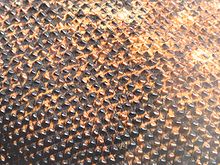
The Komodo dragon has a tail as long as its body, as well every bit about 60 frequently replaced, serrated teeth that can measure up to 2.five cm (1 in) in length. Its saliva is frequently claret-tinged considering its teeth are about completely covered by gingival tissue that is naturally lacerated during feeding.[27] Information technology also has a long, yellow, deeply forked tongue.[5] Komodo dragon peel is reinforced by armoured scales, which contain tiny bones called osteoderms that role as a sort of natural concatenation-mail.[28] [29] The only areas defective osteoderms on the head of the adult Komodo dragon are around the eyes, nostrils, mouth margins, and pineal center, a light-sensing organ on the height of the caput. Where lizards typically take one or two varying patterns or shapes of osteoderms, komodos have four: rosette, platy, dendritic, and vermiform.[30] This rugged hide makes Komodo dragon skin a poor source of leather. Additionally, these osteoderms go more extensive and variable in shape as the Komodo dragon ages, ossifying more than extensively as the cadger grows. These osteoderms are absent in hatchlings and juveniles, indicating that the natural armor develops as a product of age and competition between adults for protection in intraspecific combat over food and mates.[31]
Senses
Komodo dragon using its tongue to sample the air
As with other varanids, Komodo dragons have only a single ear os, the stapes, for transferring vibrations from the tympanic membrane to the cochlea. This organization means they are likely restricted to sounds in the 400 to 2,000 hertz range, compared to humans who hear betwixt xx and 20,000 hertz.[5] [32] They were formerly idea to exist deafened when a study reported no agitation in wild Komodo dragons in response to whispers, raised voices, or shouts. This was disputed when London Zoological Garden employee Joan Procter trained a captive specimen to come out to feed at the sound of her voice, fifty-fifty when she could not exist seen.[33]
The Komodo dragon can see objects equally far away as 300 m (980 ft), but because its retinas only incorporate cones, information technology is idea to have poor night vision. It can distinguish colours, but has poor visual bigotry of stationary objects.[34]
Equally with many other reptiles, the Komodo dragon primarily relies on its tongue to detect, gustatory modality, and smell stimuli, with the vomeronasal sense using the Jacobson's organ, rather than using the nostrils.[35] With the assistance of a favorable wind and its habit of swinging its head from side to side as information technology walks, a Komodo dragon may be able to find carrion from iv–nine.5 km (2.v–5.nine mi) abroad.[34] Information technology only has a few taste buds in the back of its throat.[35] Its scales, some of which are reinforced with os, have sensory plaques connected to nerves to facilitate its sense of touch. The scales around the ears, lips, chin, and soles of the feet may take three or more than sensory plaques.[27]
Behaviour and ecology

Male komodo dragons fighting
The Komodo dragon prefers hot and dry places and typically lives in dry out, open grassland, savanna, and tropical forest at low elevations. As an ectotherm, information technology is most agile in the day, although information technology exhibits some nocturnal activity. Komodo dragons are solitary, coming together only to breed and eat. They are capable of running rapidly in cursory sprints upward to 20 km/h (12 mph), diving up to 4.5 k (15 ft), and climbing trees proficiently when immature through use of their strong claws.[25] To take hold of out-of-reach prey, the Komodo dragon may stand on its hind legs and use its tail as a support.[33] Equally it matures, its claws are used primarily equally weapons, as its neat size makes climbing impractical.[27]
For shelter, the Komodo dragon digs holes that can measure from one to 3 yard (3.3 to ix.viii ft) wide with its powerful forelimbs and claws.[36] Because of its large size and habit of sleeping in these burrows, it is able to conserve body heat throughout the night and minimise its basking period the forenoon later.[37] The Komodo dragon hunts in the afternoon, but stays in the shade during the hottest part of the day.[9] These special resting places, commonly located on ridges with absurd sea breezes, are marked with debris and are cleared of vegetation. They serve as strategic locations from which to ambush deer.[38]
Nutrition

Komodo dragons are apex predators.[39] They are carnivores; although they have been considered as eating mostly carrion,[40] they volition frequently ambush live prey with a stealthy approach. When suitable prey arrives near a dragon's ambush site, it volition suddenly accuse at the creature at high speeds and go for the underside or the pharynx.[27]
Komodo dragons do not deliberately allow the prey to escape with fatal injuries just try to impale prey outright using a combination of lacerating damage and blood loss. They have been recorded as killing wild pigs within seconds,[41] and observations of Komodo dragons tracking casualty for long distances are likely misinterpreted cases of prey escaping an assail earlier succumbing to infection.[42] Komodo dragons accept been observed knocking down large pigs and deer with their strong tails.[43] [41] They are able to locate carcasses using their keen sense of aroma, which tin locate a dead or dying animal from a range of up to 9.5 km (v.9 mi).
Komodo dragons eat by tearing large chunks of flesh and swallowing them whole while holding the carcass down with their forelegs. For smaller prey up to the size of a caprine animal, their loosely articulated jaws, flexible skulls, and expandable stomachs allow them to swallow prey whole. The undigested vegetable contents of a prey brute's stomach and intestines are typically avoided.[38] Copious amounts of cerise saliva the Komodo dragons produce help to lubricate the nutrient, simply swallowing is still a long process (fifteen–xx minutes to swallow a goat). A Komodo dragon may attempt to speed up the process by ramming the carcass against a tree to force information technology down its pharynx, sometimes ramming so forcefully that the tree is knocked down.[38] A small tube under the tongue that connects to the lungs allows it to breathe while swallowing.[27]
After eating up to 80% of its body weight in ane repast,[39] it drags itself to a sunny location to speed digestion, as the food could rot and poison the dragon if left undigested in its stomach for likewise long. Because of their boring metabolism, large dragons can survive on equally few as 12 meals a year.[27] Afterwards digestion, the Komodo dragon regurgitates a mass of horns, pilus, and teeth known as the gastric pellet, which is covered in malodorous fungus. After regurgitating the gastric pellet, it rubs its face up in the dirt or on bushes to get rid of the mucus, suggesting it does non relish the olfactory property of its own excretions.[27]
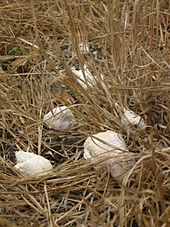
Komodo excrement has a dark portion, which is stool, and a whitish portion, which is urate, the nitrogenous end-product of their digestion process
The eating habits of Komodo dragons follow a hierarchy, with the larger animals generally eating before the smaller ones. The largest male typically asserts his authorisation and the smaller males show their submission by use of body language and rumbling hisses. Dragons of equal size may resort to "wrestling." Losers usually retreat, though they have been known to exist killed and eaten past victors.[44] [45]
The Komodo dragon's nutrition is wide-ranging, and includes invertebrates, other reptiles (including smaller Komodo dragons), birds, bird eggs, pocket-sized mammals, monkeys, wild boar, goats, deer, horses, and water buffalo.[46] Young Komodos will eat insects, eggs, geckos, and small mammals, while adults adopt to hunt large mammals.[40] Occasionally, they assault and bite humans. Sometimes they consume homo corpses, digging up bodies from shallow graves.[33] This habit of raiding graves acquired the villagers of Komodo to motion their graves from sandy to dirt footing, and pile rocks on top of them, to deter the lizards.[38] The Komodo dragon may have evolved to feed on the extinct dwarf elephant Stegodon that once lived on Flores, co-ordinate to evolutionary biologist Jared Diamond.[47]
The Komodo dragon drinks by sucking water into its mouth via buccal pumping (a process besides used for respiration), lifting its head, and letting the water run downwards its throat.[41]
Saliva
Although previous studies proposed that Komodo dragon saliva contains a variety of highly septic leaner that would help to bring down prey,[44] [48] inquiry in 2013 suggested that the bacteria in the mouths of Komodo dragons are ordinary and like to those found in other carnivores. Komodo dragons have good mouth hygiene. To quote Bryan Fry: "Afterward they are done feeding, they will spend 10 to 15 minutes lip-licking and rubbing their head in the leaves to clean their mouth ... Unlike people take been led to believe, they do non have chunks of rotting flesh from their meals on their teeth, cultivating bacteria." Nor do Komodo dragons wait for prey to die and track it at a distance, as vipers do; observations of them hunting deer, boar and in some cases buffalo reveal that they kill prey in less than one-half an hour.[42] [49]
The ascertainment of prey dying of sepsis would and then be explained by the natural instinct of water buffalos, who are non native to the islands where the Komodo dragon lives, to encounter h2o afterwards escaping an attack. The warm, faeces-filled water would then cause the infections.[42] The study used samples from sixteen convict dragons (10 adults and six neonates) from iii U.s. zoos.[50]
Antibacterial allowed factor
Researchers take isolated a powerful antibacterial peptide from the blood plasma of Komodo dragons, VK25. Based on their analysis of this peptide, they have synthesized a brusk peptide dubbed DRGN-1 and tested it confronting multidrug-resistant (MDR) pathogens. Preliminary results of these tests show that DRGN-1 is effective in killing drug-resistant bacterial strains and fifty-fifty some fungi. Information technology has the added observed benefit of significantly promoting wound healing in both uninfected and mixed biofilm infected wounds.[51]
Venom

In late 2005, researchers at the University of Melbourne speculated the perentie (Varanus giganteus), other species of monitors, and agamids may be somewhat venomous. The team believes the immediate furnishings of bites from these lizards were caused past balmy envenomation. Bites on homo digits by a lace monitor (V. varius), a Komodo dragon, and a spotted tree monitor (Five. scalaris) all produced similar furnishings: rapid swelling, localised disruption of claret clotting, and shooting pain up to the elbow, with some symptoms lasting for several hours.[52]
In 2009, the same researchers published further show demonstrating Komodo dragons possess a venomous bite. MRI scans of a preserved skull showed the presence of two glands in the lower jaw. The researchers extracted ane of these glands from the head of a terminally ill dragon in the Singapore Zoological Gardens, and found it secreted several unlike toxic proteins. The known functions of these proteins include inhibition of blood clotting, lowering of blood pressure level, musculus paralysis, and the induction of hypothermia, leading to stupor and loss of consciousness in envenomated prey.[53] [54] Equally a result of the discovery, the previous theory that leaner were responsible for the deaths of Komodo victims was disputed.[55]
Other scientists have stated that this allegation of venom glands "has had the upshot of underestimating the diversity of complex roles played by oral secretions in the biology of reptiles, produced a very narrow view of oral secretions and resulted in misinterpretation of reptilian evolution." According to these scientists "reptilian oral secretions contribute to many biological roles other than to rapidly dispatch prey." These researchers concluded that, "Calling all in this clade venomous implies an overall potential danger that does not exist, misleads in the cess of medical risks, and confuses the biological assessment of squamate biochemical systems."[56] Evolutionary biologist Schwenk says that even if the lizards have venom-like proteins in their mouths they may be using them for a different function, and he doubts venom is necessary to explain the upshot of a Komodo dragon bite, arguing that shock and blood loss are the primary factors.[57] [58]
Reproduction
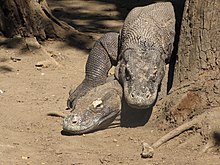
Mating occurs between May and Baronial, with the eggs laid in September.[5] [59] During this period, males fight over females and territory by grappling with i another upon their hind legs, with the loser eventually being pinned to the ground. These males may vomit or defecate when preparing for the fight.[33] The winner of the fight will then moving picture his long tongue at the female to gain information about her receptivity.[39] Females are combative and resist with their claws and teeth during the early on phases of courtship. Therefore, the male must fully restrain the female person during coitus to avoid existence injure. Other courtship displays include males rubbing their chins on the female, hard scratches to the back, and licking.[60] Copulation occurs when the male inserts ane of his hemipenes into the female person'south cloaca.[34] Komodo dragons may be monogamous and form "pair bonds," a rare behavior for lizards.[33]
Female Komodos lay their eggs from August to September and may employ several types of locality; in one study, 60% laid their eggs in the nests of orangish-footed scrubfowl (a moundbuilder or megapode), twenty% on ground level and twenty% in hilly areas.[61] The females brand many camouflage nests/holes to prevent other dragons from eating the eggs.[62] Clutches contain an average of xx eggs, which have an incubation period of 7–8 months.[33] Hatching is an exhausting effort for the neonates, which suspension out of their eggshells with an egg tooth that falls off shortly. Later cut themselves out, the hatchlings may lie in their eggshells for hours before starting to dig out of the nest. They are born quite caught and are vulnerable to predation.[44] Sixteen youngsters from a single nest were on average 46.5 cm long and weighed 105.1 grams.[61]
Young Komodo dragons spend much of their first few years in copse, where they are relatively safety from predators, including cannibalistic adults, as juvenile dragons make upwards 10% of their diets.[33] The addiction of cannibalism may be advantageous in sustaining the large size of adults, as medium-sized casualty on the islands is rare.[43] When the young arroyo a kill, they roll around in faecal matter and residual in the intestines of eviscerated animals to deter these hungry adults.[33] Komodo dragons take approximately eight to 9 years to mature, and may live for up to 30 years.[59]
Parthenogenesis
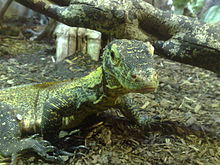
A Komodo dragon at London Zoo named Sungai laid a clutch of eggs in late 2005 after existence separated from a male visitor for more than than two years. Scientists initially causeless she had been able to store sperm from her earlier encounter with a male, an accommodation known as superfecundation.[63] On 20 December 2006, it was reported that Flora, a convict Komodo dragon living in the Chester Zoo in England, was the 2nd known Komodo dragon to have laid unfertilised eggs: she laid 11 eggs, and seven of them hatched, all of them male.[64] Scientists at Liverpool University in England performed genetic tests on three eggs that collapsed after being moved to an incubator, and verified Flora had never been in concrete contact with a male dragon. After Flora'south eggs' status had been discovered, testing showed Sungai's eggs were likewise produced without outside fertilization.[65] On 31 January 2008, the Sedgwick Canton Zoo in Wichita, Kansas, became the first zoo in the Americas to document parthenogenesis in Komodo dragons. The zoo has two adult female Komodo dragons, one of which laid well-nigh 17 eggs on 19–20 May 2007. Only two eggs were incubated and hatched due to space problems; the starting time hatched on 31 January 2008, while the second hatched on 1 February. Both hatchlings were males.[66] [67]
Komodo dragons have the ZW chromosomal sex-determination organisation, as opposed to the mammalian XY organization. Male progeny prove Flora'south unfertilized eggs were haploid (n) and doubled their chromosomes afterwards to become diploid (2n) (past existence fertilized by a polar body, or by chromosome duplication without cell segmentation), rather than by her laying diploid eggs by ane of the meiosis reduction-divisions in her ovaries failing. When a female person Komodo dragon (with ZW sex chromosomes) reproduces in this mode, she provides her progeny with simply one chromosome from each of her pairs of chromosomes, including only one of her two sex chromosomes. This single set of chromosomes is duplicated in the egg, which develops parthenogenetically. Eggs receiving a Z chromosome become ZZ (male person); those receiving a West chromosome become WW and fail to develop,[68] [69] pregnant that just males are produced past parthenogenesis in this species.
It has been hypothesised that this reproductive adaptation allows a single female person to enter an isolated ecological niche (such equally an island) and by parthenogenesis produce male offspring, thereby establishing a sexually reproducing population (via reproduction with her offspring that can upshot in both male and female young).[68] Despite the advantages of such an accommodation, zoos are cautioned that parthenogenesis may be detrimental to genetic diverseness.[seventy]
Incidents with humans
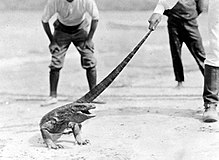
Humans treatment a komodo dragon
Attacks on humans are rare, but Komodo dragons take been responsible for several human fatalities, in both the wild and in captivity. Co-ordinate to data from Komodo National Park spanning a 38-year period betwixt 1974 and 2012, at that place were 24 reported attacks on humans, five of them fatal. Almost of the victims were local villagers living around the national park.[71] Reports of attacks include:[72]
- 1974: A visiting Swiss tourist, Baron Rudolf von Reding von Biberegg, who disappeared on Komodo Isle, may have been killed and eaten by Komodo dragons.[73]
- 2001: A Komodo dragon attacked Phil Bronstein, an investigative journalist and sometime husband of actress Sharon Stone, in the Los Angeles Zoo.[72]
- 2007: An 8-year-one-time boy on Komodo Island died from his injuries after beingness attacked by ane.[72]
- 2008: A group of five scuba divers were stranded on the beach of Rinca Isle, and were attacked past Komodo dragons. After two days, the defined' ordeal ended when they were picked up by an Indonesian rescue boat.[72]
- 2009: a 31-year-one-time Komodo Isle local, died from his injuries later after existence attacked by 2 dragons. He had fallen from a tree while he was picking sugar apples.[72]
- 2009: Maen, a national park guide stationed on Rinca Isle, was ambushed and bitten by a Komodo dragon which had walked into his role and lay under his desk-bound. Despite suffering some injuries, the guide survived.[72]
- May 2017: Lon Lee Alle, a 50-year-old Singaporean tourist (or Loh Lee Aik, said to be 68), was attacked past a Komodo dragon on Komodo Island.[74] The victim survived the attack, merely his left leg was severely injured.[75]
- November 2017: Yosef Paska, a local construction worker, was attacked on Rinca Isle and taken to Labuan Bajo past speedboat for treatment.[76]
Conservation
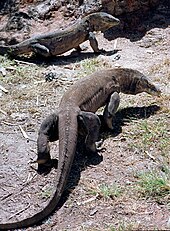
The Komodo dragon is classified by the IUCN equally Endangered and is listed on the IUCN Red List.[2] The species' sensitivity to natural and man-made threats has long been recognized by conservationists, zoological societies, and the Indonesian authorities. Komodo National Park was founded in 1980 to protect Komodo dragon populations on islands including Komodo, Rinca, and Padar.[77] Afterwards, the Wae Wuul and Wolo Tado Reserves were opened on Flores to assistance Komodo dragon conservation.[thirteen]
Komodo dragons generally avoid encounters with humans. Juveniles are very shy and will flee speedily into a hideout if a human comes closer than most 100 metres (330 ft). Older animals will also retreat from humans from a shorter distance away. If cornered, they may react aggressively by gaping their mouth, hissing, and swinging their tail. If they are disturbed further, they may assail and bite. Although at that place are anecdotes of unprovoked Komodo dragons attacking or preying on humans, well-nigh of these reports are either not reputable or have subsequently been interpreted as defensive bites. Merely very few cases are truly the consequence of unprovoked attacks by atypical individuals who lost their fear of humans.[44]
Volcanic action, earthquakes, loss of habitat, fire,[27] [13] tourism, loss of casualty due to poaching, and illegal poaching of the dragons themselves have all contributed to the vulnerable status of the Komodo dragon. A major future threat to the species is climatic change via both aridification and sea level ascension, which can affect the low-lying habitats and valleys that the Komodo dragon depends on, as Komodo dragons do not range into the higher-altitude regions of the islands they inhabit. Based on projections, climate change will lead to a decline in suitable habitat of 8.4%, 30.2%, or 71% by 2050 depending on the climate change scenario. Without effective conservation actions, populations on Flores are extirpated in all scenarios, while in the more extreme scenarios, simply the populations on Komodo and Rinca persist in highly reduced numbers. Rapid climate change mitigation is crucial for conserving the species in the wild.[24] [78] Other scientists take disputed the conclusions about the effects of climatic change on Komodo dragon populations.[79]
Nether Appendix I of CITES (the Convention on International Trade in Endangered Species), commercial international trade of Komodo dragon skins or specimens is prohibited.[80] [81] Despite this, at that place are occasional reports of illegal attempts to merchandise in alive Komodo dragons. The most recent attempt was in March 2019, when Indonesian police force in the East Coffee urban center of Surabaya reported that a criminal network had been defenseless trying to smuggle 41 young Komodo dragons out of Republic of indonesia. The plan was said to include shipping the animals to several other countries in Southeast Asia through Singapore. It was hoped that the animals could be sold for up to 500 one thousand thousand rupiah (effectually The states$35,000) each.[82] Information technology was believed that the Komodo dragons had been smuggled out of E Nusa Tenggara province through the port at Ende in central Flores.[83]
In 2013, the total population of Komodo dragons in the wild was assessed every bit 3,222 individuals, failing to iii,092 in 2014 and three,014 in 2015. Populations remained relatively stable on the bigger islands (Komodo and Rinca), simply decreased on smaller islands, such as Nusa Kode and Gili Motang, likely due to diminishing prey availability.[84] On Padar, a one-time population of Komodo dragons has recently become extinct, of which the final individuals were seen in 1975.[85] It is widely assumed that the Komodo dragon died out on Padar following a major pass up of populations of large ungulate prey, for which poaching was most likely responsible.[86]
In captivity
Komodo dragons have long been sought-after zoo attractions, where their size and reputation brand them popular exhibits. They are, however, rare in zoos because they are susceptible to infection and parasitic disease if captured from the wild, and do not readily reproduce in captivity.[xv] The first Komodo dragons were displayed at London Zoo in 1927. A Komodo dragon was exhibited in 1934 in the United states of america at the National Zoo in Washington, D.C., simply information technology lived for merely two years. More attempts to exhibit Komodo dragons were made, simply the lifespan of the animals proved very brusque, averaging v years in the National Zoological Park. Studies were done past Walter Auffenberg, which were documented in his book The Behavioral Ecology of the Komodo Monitor, somewhen allowed for more successful management and convenance of the dragons in captivity.[12] As of May 2009, in that location were 35 Due north American, thirteen European, one Singaporean, two African, and two Australian institutions which housed captive Komodo dragons.[87]
A multifariousness of behaviors accept been observed from captive specimens. Most individuals become relatively tame within a short time,[88] [89] and are capable of recognising individual humans and discriminating betwixt familiar and unfamiliar keepers.[90] Komodo dragons have also been observed to engage in play with a multifariousness of objects, including shovels, cans, plastic rings, and shoes. This behavior does non seem to be "food-motivated predatory beliefs."[39] [5] [91]
Even seemingly docile dragons may get unpredictably ambitious, especially when the animal's territory is invaded by someone unfamiliar. In June 2001, a Komodo dragon seriously injured Phil Bronstein, the and so-husband of extra Sharon Stone, when he entered its enclosure at the Los Angeles Zoo afterward beingness invited in by its keeper. Bronstein was bitten on his bare human foot, as the keeper had told him to take off his white shoes and socks, which the keeper stated could potentially excite the Komodo dragon as they were the same colour as the white rats the zoo fed the dragon.[92] [93] Although he survived, Bronstein needed to have several tendons in his foot reattached surgically.[94]
See also
- Asian water monitor
- Komodo Indonesian Fauna Museum and Reptile Park
- Papua monitor (Varanus salvadorii), a monitor cadger often asserted to exist the longest extant lizard
- Toxicofera, a hypothetical clade encompassing all venomous reptiles, including the Komodo dragon
- Varanus priscus (formerly known as Megalania prisca), a huge extinct varanid lizard of Pleistocene Australia
References
- ^ a b c Hocknull SA, Piper PJ, van den Bergh GD, Due RA, Morwood MJ, Kurniawan I (2009). "Dragon's Paradise Lost: Palaeobiogeography, Evolution and Extinction of the Largest-Ever Terrestrial Lizards (Varanidae)". PLOS ONE. 4 (9): e7241. Bibcode:2009PLoSO...4.7241H. doi:x.1371/periodical.pone.0007241. PMC2748693. PMID 19789642.
- ^ a b Jessop, T.; Ariefiandy, A.; Azmi, M.; Ciofi, C.; Imansyah, J.; Purwandana, D. (2021). "Varanus komodoensis". IUCN Red List of Threatened Species. 2021: e.T22884A123633058. doi:10.2305/IUCN.Great britain.2021-2.RLTS.T22884A123633058.en . Retrieved xix November 2021.
- ^ "Appendices | CITES". cites.org . Retrieved 14 January 2022.
- ^ a b Ouwens, P. A. (1912). "On a large Varanus species from the island of Komodo". Bulletin de l'Institut Botanique de Buitenzorg. two. 6: 1–3. Retrieved six March 2017.
- ^ a b c d e f one thousand h Ciofi, Claudio (March 1999). "The Komodo Dragon". Scientific American. 280 (3): 84–91. Bibcode:1999SciAm.280c..84C. doi:x.1038/scientificamerican0399-84.
- ^ Chalmers Mitchell, Peter (15 June 1927). "Reptiles at the Zoo: Opening of new house today". The London Times. London, United kingdom of great britain and northern ireland. p. 17.
- ^ Procter, J. B. (1928). "On a living Komodo dragon Varanus komodoensis Ouwens, exhibited at the Scientific Meeting, Oct 23rd, 1928". Proceedings of the Zoological Society of London. 98 (4): 1017–19. doi:10.1111/j.1469-7998.1928.tb07181.10.
- ^ Rony, Fatimah Tobing (1996). The tertiary heart: Race, picture palace, and ethnographic spectacle. Durham, N.C.: Knuckles University Printing. p. 164. ISBN978-0-8223-1840-eight.
- ^ a b "Komodo National Park Frequently Asked Questions". Komodo Foundation. Retrieved 25 October 2007.
- ^ "American Museum of Natural History: Komodo Dragons". American Museum of Natural History. Archived from the original on 23 November 2010. Retrieved 7 June 2007.
- ^ Cheater, Mark (August–September 2003). "Chasing the Magic Dragon". National Wildlife Magazine. 41 (5). Archived from the original on xx Feb 2009.
- ^ a b Walsh, Trooper; Tater, James Jerome; Ciofi, Claudio; De LA Panouse, Colomba (2002). Komodo Dragons: Biology and Conservation. Zoo and Aquarium Biological science and Conservation Series. Washington, D.C.: Smithsonian Books. ISBN978-ane-58834-073-iii.
- ^ a b c "Trapping Komodo Dragons for Conservation". National Geographic. Retrieved viii November 2007.
- ^ "Varanus komodoensis". Integrated Taxonomic Information Arrangement. Retrieved xix June 2007.
- ^ a b "Ora (Komodo Island Monitor or Komodo Dragon)". American Museum of Natural History. Archived from the original on vii March 2010. Retrieved xv January 2007.
- ^ "Commonwealth of australia was 'hothouse' for killer lizards". Australian Broadcasting Corporation. 30 September 2009. Retrieved 30 September 2009.
- ^ Hocknull, S.A.; Piper, P.J.; van den Bergh, G.D.; Due, R.A.; Morwood, M.J.; Kurniawan, I. (2009). "Dragon's paradise lost: palaeobiogeography, evolution and extinction of the largest-ever terrestrial lizards (Varanidae)". PLOS I. 4 (9): e7241. Bibcode:2009PLoSO...4.7241H. doi:10.1371/journal.pone.0007241. PMC2748693. PMID 19789642.
- ^ Vidal, Northward.; Marin, J.; Sassi, J.; Battistuzzi, F.U.; Donnellan, Southward.; Fitch, A.J.; et al. (2012). "Molecular testify for an Asian origin of monitor lizards followed by 3rd dispersals to Africa and Australasia". Biology Letters. 8 (5): 853–855. doi:10.1098/rsbl.2012.0460. PMC3441001. PMID 22809723.
- ^ Fitch AJ, Goodman AE, Donnellan SC (2006). "A molecular phylogeny of the Australian monitor lizards (Squamata: Varanidae) inferred from mitochondrial DNA sequences". Australian Journal of Zoology. 54 (4): 253–269. doi:10.1071/ZO05038.
- ^ Ast, Jennifer C. (2001). "Mitochondrial Deoxyribonucleic acid evidence and evolution in Varanoidea (Squamata)" (PDF). Cladistics. 17 (iii): 211–226. doi:10.1006/clad.2001.0169. hdl:2027.42/72302. ; Ast, J.C. "erratum". Cladistics. 18 (1): 125. doi:10.1006/clad.2002.0198.
- ^ Pavón-Vázquez, Carlos J.; Brennan, Ian 1000.; Keogh, J. Scott (2021). "A Comprehensive Approach to Discover Hybridization Sheds Light on the Evolution of Earth'south Largest Lizards". Systematic Biological science. lxx (5): 877–890. doi:10.1093/sysbio/syaa102. PMID 33512509.
- ^ "Study reveals surprising history of world's largest lizard". phys.org . Retrieved 6 March 2021.
- ^ "Komodo dragons not merely inhabited ancient Australia, but also mated with our sand monitors". Australian Geographic. three March 2021. Retrieved 6 March 2021.
- ^ a b Plan), Jeri Imansyah (Komodo Survival; Ariefiandy, Achmad; Azmi, Muhammad; Ciofi, Claudio; Purwandana, Deni; Jessop, Tim (5 August 2019). "IUCN Crimson List of Threatened Species: Varanus komodoensis". IUCN Ruddy List of Threatened Species . Retrieved 6 September 2021.
- ^ a b Burnie, David; Don Eastward. Wilson (2001). Animal. New York: DK Publishing. pp. 417, 420. ISBN978-0-7894-7764-four.
- ^ Wood, Gerald (1983). The Guinness Volume of Animal Facts and Feats. ISBN978-0-85112-235-9.
- ^ a b c d e f yard h Tara Darling (Illustrator) (1997). Komodo Dragon: On Location (Darling, Kathy. on Location.) . Lothrop, Lee and Shepard Books. ISBN978-0-688-13777-nine.
- ^ Komodo Dragons Archived 27 September 2013 at the Wayback Machine . London Zoo
- ^ Komodo Dragon, Varanus komodoensis 1998. Physical Characteristics Archived 17 January 2010 at the Wayback Machine . San Diego Zoo Global Zoo (1998).
- ^ Hern, Daisy; ez (29 September 2019). "Here'southward Why Komodo Dragons are the Toughest Lizards on Earth". Popular Mechanics . Retrieved 9 July 2020.
- ^ "Elaborate Komodo dragon armor defends against other dragons".
- ^ "Komodo Conundrum". BBC. Archived from the original on 16 November 2006. Retrieved 25 November 2007.
- ^ a b c d e f g h David Badger; photography past John Netherton (2002). Lizards: A Natural History of Some Uncommon Creatures, Extraordinary Chameleons, Iguanas, Geckos, and More than. Stillwater, MN: Voyageur Printing. pp. 32, 52, 78, 81, 84, 140–145, 151. ISBN978-0-89658-520-1.
- ^ a b c "Komodo Dragon Fact Sheet". National Zoological Park. 25 April 2016. Retrieved 25 Nov 2007.
- ^ a b "Komodo Dragon". Singapore Zoological Gardens. Archived from the original on 14 February 2005. Retrieved 21 December 2006.
- ^ Cogger, Harold Thousand.; Zweifel, Richard G., eds. (1998). Encyclopedia of Reptiles & Amphibians. Illustrations by David Kirshner. Boston: Bookish Press. pp. 132, 157–58. ISBN978-0-12-178560-iv.
- ^ Eric R. Pianka; Laurie J. Vitt; with a foreword past Harry W. Greene (2003). Lizards: Windows to the Evolution of Multifariousness. Berkeley: University of California Press. p. 244. ISBN978-0-520-23401-7.
{{cite volume}}: CS1 maint: multiple names: authors list (link) - ^ a b c d Ballance, Alison; Morris, Rod (2003). Due south Bounding main Islands: A natural history. Hove: Firefly Books Ltd. ISBN978-ane-55297-609-eight.
- ^ a b c d Halliday, Tim; Adler, Kraig, eds. (2002). Firefly Encyclopedia of Reptiles and Amphibians. Hove: Firefly Books. pp. 112–13, 144, 147, 168–69. ISBN978-ane-55297-613-5.
- ^ a b Mattison, Chris (1992) [1989]. Lizards of the Earth. New York: Facts on File. pp. sixteen, 57, 99, 175. ISBN978-0-8160-5716-0.
- ^ a b c Auffenberg, Walter (1981). The Behavioral Ecology of the Komodo Monitor. Gainesville, Florida: University Presses of Florida. ISBN978-0-8130-0621-5.
- ^ a b c Wilcox, Christie (25 June 2013). "Here Be Dragons: The Mythic Bite of the Komodo". Discover . Retrieved 12 February 2021.
- ^ a b Attenborough, David (2008). Life in Cold Blood . Princeton, N.J.: Princeton Academy Press. ISBN978-0-691-13718-6.
- ^ a b c d Auffenberg, Walter (1981). The Behavioral Ecology of the Komodo Monitor. Gainesville: Academy Presses of Florida. p. 406. ISBN978-0-8130-0621-5.
- ^ Mader, Douglas R. (1996). Reptile Medicine and Surgery. WB Saunders Co. p. 16. ISBN0721652085.
- ^ Vidal, John (12 June 2008). "The terrifying truth nearly Komodo dragons". guardian.co.uk. London, Uk. Retrieved 19 June 2008.
- ^ Diamond, Jared Grand. (1987). "Did Komodo dragons evolve to consume pygmy elephants?". Nature. 326 (6116): 832. Bibcode:1987Natur.326..832D. doi:10.1038/326832a0. S2CID 37203256.
- ^ Montgomery, JM; Gillespie, D; Sastrawan, P; Fredeking, TM; Stewart, GL (2002). "Aerobic salivary bacteria in wild and captive Komodo dragons" (PDF). Journal of Wildlife Diseases. 38 (3): 545–51. doi:ten.7589/0090-3558-38.3.545. PMID 12238371. S2CID 9670009. Archived from the original (PDF) on 14 Dec 2007.
- ^ Goldstein, Ellie J. C.; Tyrrell, Kerin Fifty.; Citron, Diane Thou.; Cox, Cathleen R.; Recchio, Ian M.; Okimoto, Ben; Bryja, Judith; Fry, Bryan G. (June 2013). "Anaerobic and aerobic bacteriology of the saliva and gingiva from 16 captive Komodo dragons (Varanus komodoensis): new implications for the "bacteria as venom" model". Journal of Zoo and Wild animals Medicine. 44 (two): 262–272. doi:x.1638/2012-0022R.i. ISSN 1042-7260. PMID 23805543. S2CID 9932073.
- ^ Goldstein, E.J.C.; Tyrrell, K.Fifty.; Citron, D.1000.; Cox, C.R.; Recchio, I.Thou.; Okimoto, B.; Bryja, J.; Fry, B.G. (2013). "Anaerobic and aerobic bacteriology of the saliva and gingiva from 16 captive Komodo dragons (Varanus Komodoensis): New implications for the "Bacteria as Venom" model" (PDF). Journal of Zoo and Wild animals Medicine. 44 (ii): 262–72. doi:10.1638/2012-0022R.one. PMID 23805543. S2CID 9932073. Archived from the original (PDF) on 16 September 2013.
- ^ Chung, Ezra Thousand. C.; Dean, Scott N.; Propst, Crystal N.; Bishop, Barney M.; van Hoek, Monique L. (11 April 2017). "Komodo dragon-inspired synthetic peptide DRGN-i promotes wound-healing of a mixed-biofilm infected wound". NPJ Biofilms and Microbiomes. iii (1): 9. doi:ten.1038/s41522-017-0017-2. ISSN 2055-5008. PMC5445593. PMID 28649410.
- ^ Fry, BG; Vidal, N; Norman, JA; Vonk, FJ; Scheib, H; Ramjan, SF; Kuruppu, S; Fung, Grand; et al. (2006). "Early evolution of the venom organization in lizards and snakes" (PDF). Nature. 439 (7076): 584–588. Bibcode:2006Natur.439..584F. doi:10.1038/nature04328. PMID 16292255. S2CID 4386245.
- ^ Scientists discover deadly secret of Komodo's seize with teeth, AFP, 19 May 2009
- ^ Fry BG, Wroe South, Teeuwisse West, et al. (2009). "A central role for venom in predation by Varanus komodoensis (Komodo Dragon) and the extinct behemothic Varanus (Megalania) priscus". Proceedings of the National Academy of Sciences of the U.s. of America. 106 (22): 8969–74. Bibcode:2009PNAS..106.8969F. doi:ten.1073/pnas.0810883106. PMC2690028. PMID 19451641.
- ^ Staff. "Komodo dragons impale with venom, not bacteria, report says". CNN. xx May 2009. Retrieved on 25 May 2009.
- ^ Weinstein, Scott A.; Smith, Tamara Fifty.; Kardong, Kenneth V. (14 July 2009). "Reptile Venom Glands Form, Part, and Future". In Stephen P. Mackessy (ed.). Handbook of Venoms and Toxins of Reptiles. Taylor & Francis. pp. 76–84. ISBN978-1-4200-0866-1 . Retrieved 18 July 2013.
- ^ Zimmer, Carl (May 2009). "Venom Might Boost Dragons Bite". San Diego Tribune. Archived from the original on xviii Dec 2014. Retrieved 26 September 2009.
- ^ Zimmer, Carl (xviii May 2009). "Chemicals in Dragon's Glands Stir Venom Debate". The New York Times. p. D2. Retrieved 23 March 2012.
- ^ a b Ciofi, Claudio (2004). Varanus komodoensis. Varanoid Lizards of the World. Bloomington & Indianapolis: Indiana University Press. pp. 197–204. ISBN978-0-253-34366-6.
- ^ "Komodo Dragon, Varanus komodoensis". San Diego Zoo. Archived from the original on 17 January 2010. Retrieved 27 October 2009.
- ^ a b Markus Makur (2015). "'Wotong' bird nests help Komodos survive: Study". The Jakarta Post . Retrieved eleven March 2015.
- ^ Jessop, Tim S.; Sumner, Joanna; Rudiharto, Heru; Purwandana, Deni; Imansyah, M.Jeri; Phillips, John A. (2004). "Distribution, apply and selection of nest blazon by Komodo dragons" (PDF). Biological Conservation. 117 (5): 463. doi:10.1016/j.biocon.2003.08.005. Archived from the original (PDF) on 9 Dec 2011.
- ^ Morales, Alex (20 Dec 2006). "Komodo Dragons, World's Largest Lizards, Have Virgin Births". Bloomberg Television. Archived from the original on eight Oct 2007. Retrieved 28 March 2008.
- ^ Discover by her cage in Chester Zoo in England
- ^ Henderson, Mark (21 December 2006). "Wise men testify to Dragon'south virgin nascency". The Times. London. Retrieved 26 November 2007.
- ^ "Recent News – Sedgwick Canton Zoo". Sedgwick County Zoo. Archived from the original on 11 February 2008. Retrieved 12 February 2008.
- ^ "Komodo dragons hatch with no male person involved". NBC News. 8 February 2008. Retrieved 12 February 2008.
- ^ a b "Virgin births for behemothic lizards". BBC News. xx Dec 2006. Retrieved xiii March 2008.
- ^ "Strange simply True: Komodo Dragons Show that "Virgin Births" Are Possible: Scientific American". Scientific American . Retrieved 24 March 2008.
- ^ Watts PC, Buley KR, Sanderson Southward, Boardman W, Ciofi C, Gibson R (December 2006). "Parthenogenesis in Komodo Dragons". Nature. 444 (7122): 1021–22. Bibcode:2006Natur.444.1021W. doi:ten.1038/4441021a. ISSN 0028-0836. PMID 17183308. S2CID 4311088.
- ^ Fariz Fardianto (22 April 2014). "5 Kasus keganasan komodo liar menyerang manusia". Merdeka.com (in Indonesian).
- ^ a b c d e f Rachel Nuwer (24 January 2013). "The Almost Infamous Komodo Dragon Attacks of the Past x Years An viii-yr-old boy; a group of stranded divers; a celebrity's husband: Just a few of the recent victims of Komodo dragon attacks". smithsonian.com.
- ^ Patricia Banzer, '[one], Radio SFR i, 18 April 2014. and Herbert Cerruti, '[2], NZZ Folio, June 2000.
- ^ Chew Hui Min, 'S'porean trourist bitten by Komodo dragon was trying to snap photos', The Straits Times, 22 May 2017.
- ^ Markus Makur (3 May 2017). "Singaporean tourist bitten by Komodo dragon". The Djakarta Postal service.
- ^ Markus Makur, 'Worker rushed to hospital later on being bitten by komodo dragon', The Jakarta Post, i December 2017.
- ^ "The official website of Komodo National Park, Republic of indonesia". Komodo National Park. Archived from the original on v February 2007. Retrieved 2 Feb 2007.
- ^ Jones, Alice R.; Jessop, Tim S.; Ariefiandy, Achmad; Brook, Barry W.; Brownish, Stuart C.; Ciofi, Claudio; Benu, Yunias Jackson; Purwandana, Deni; Sitorus, Tamen; Wigley, Tom G. Fifty.; Fordham, Damien A. (October 2020). "Identifying island rubber havens to forbid the extinction of the World's largest lizard from global warming". Ecology and Evolution. ten (xix): 10492–10507. doi:10.1002/ece3.6705. ISSN 2045-7758. PMC7548163. PMID 33072275.
- ^ Supriatna, Jatna. "Why we must reassess the komodo dragon'southward "Endangered" status". The Conversation . Retrieved 8 October 2021.
- ^ "Zipcodezoo: Varanus komodoensis (Komodo Dragon, Komodo Island Monitor, Komodo Monitor)". BayScience Foundation, Inc. Archived from the original on 12 Apr 2010. Retrieved 25 October 2009.
- ^ "Appendices I, Two and 3". CITES. Archived from the original on 11 March 2008. Retrieved 24 March 2008.
- ^ 'Constabulary foil attempt to export Komodo dragons for Rp 500 million apiece', The Jakarta Post, 28 March 2019.
- ^ Markus Makur, 'Lax security at Florest ports allows Komodo dragon smuggling', The Dki jakarta Post, nine April 2019.
- ^ Markus Makur (v March 2016). "Komodo population continues to refuse at national park".
- ^ Lilley, R. P. H. (1995). "A feasibility study on the in-situ convict breeding of Komodo dragons (Varanus komodoensis) on Padar Island, Komodo National Park". MSC. Thesis: University of Kent, Canterbury, UK.
- ^ Jessop, T.Due south.; Forsyth, D.Grand.; Purwandana, D.; Imansyah, M.J.; Opat, D.S.; McDonald-Madden, E. (2005). Monitoring the ungulate prey of komodo dragons (Varanus komodoensis) using faecal counts (Report). Zoological Society of San Diego, USA, and the Komodo National Park Say-so, Labuan Bajo, Flores, Indonesia. p. 26. CiteSeerX10.1.1.172.2230.
- ^ "ISIS Abstracts". ISIS. Retrieved four January 2009.
- ^ Procter, J.B. (October 1928). "On a living Komodo Dragon Varanus komodoensis Ouwens, exhibited at the Scientific Meeting". Proceedings of the Zoological Society of London. 98 (4): 1017–xix. doi:10.1111/j.1469-7998.1928.tb07181.ten.
- ^ Lederer, Yard. (1931). "Erkennen wechselwarme Tiere ihren Pfleger?". Wochenschrift für Aquarien- und Terrarienkunde. 28: 636–38.
- ^ Tater, James B.; Walsh, Trooper (2006). "Dragons and Humans". Herpetological Review. 37 (3): 269–75.
- ^ "Such jokers, those Komodo dragons". Science News. 162 (i): 78. August 2002. doi:x.1002/scin.5591620516.
- ^ Cagle, Jess (23 June 2001). "Transcript: Sharon Stone vs. the Komodo Dragon". Time. Archived from the original on xxx October 2010. Retrieved 20 March 2008.
- ^ Robinson, Phillip T. (2004). Life at the Zoo: Behind the Scenes with the Fauna Doctors. New York: Columbia University Printing. p. 79. ISBN978-0-231-13248-0.
- ^ Pence, Angelica (eleven June 2001). "Editor stable afterwards attack by Komodo dragon / Surgeons reattach pes tendons of Chronicle's Bronstein in L.A." San Francisco Chronicle . Retrieved 23 March 2008.
Farther reading
- Attenborough, David (1957). Zoo Quest for a Dragon. London: Lutterworth Printing.
- Auffenberg, Walter (1981). The Behavioral Ecology of the Komodo Monitor. Gainesville: University Presses of Florida. ISBN978-0-8130-0621-5.
- Brunt, W. Douglas (1927). Dragon Lizards of Komodo: An Expedition to the Lost World of the Dutch E Indies. New York, London: G.P. Putnum'due south Sons.
- Eberhard, Jo; Rex, Dennis; Dark-green, Brian; Knight, Frank; Keith Newgrain (1999). Monitors: The Biology of Varanid Lizards. Malabar, Fla: Krieger Publishing Company. ISBN978-ane-57524-112-eight.
- Lutz, Richard Fifty; Lutz, Judy Marie (1997). Komodo: The Living Dragon. Salem, Or: DiMI Press. ISBN978-0-931625-27-5.
External links
Source: https://en.wikipedia.org/wiki/Komodo_dragon
Posted by: fischerbessed1987.blogspot.com



0 Response to "How To Draw A Komodo Dragon Face"
Post a Comment